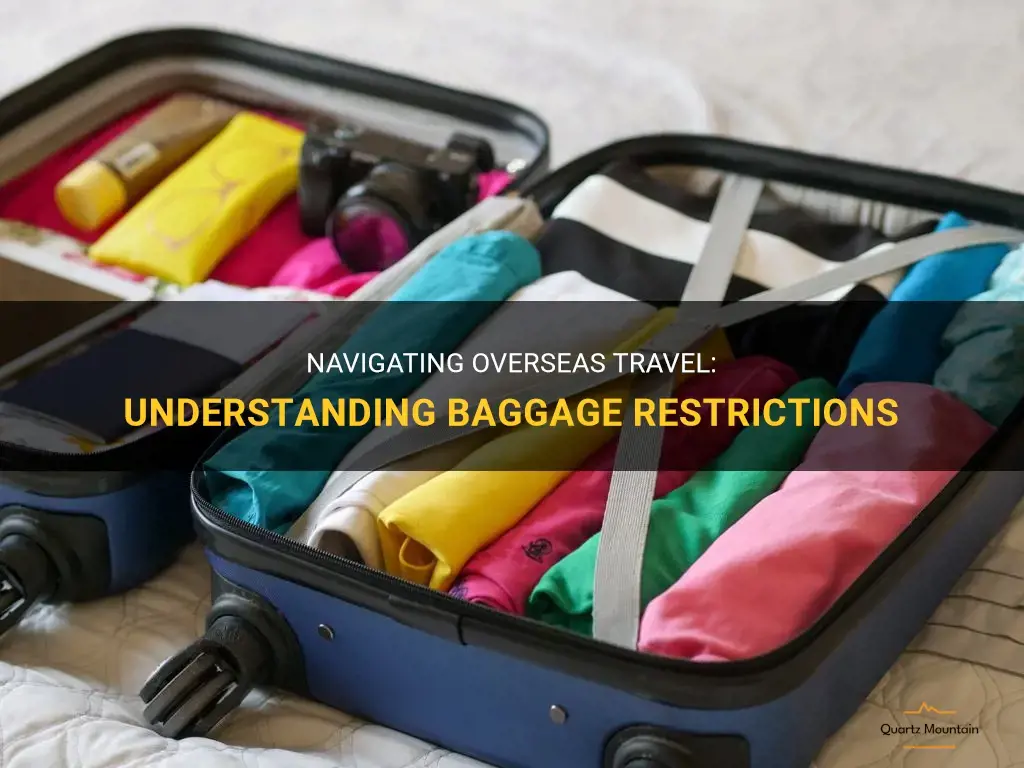
When it comes to traveling overseas, one aspect that can cause both excitement and stress is the baggage restrictions. You may find yourself questioning whether you can bring your favorite hair straightener, your beloved Swiss army knife, or even that extra bottle of sunscreen. But fear not, as we dive into the world of overseas travel baggage restrictions, we will explore the ins and outs of what you can and can't bring with you, ensuring that your journey is both hassle-free and compliant with the rules and regulations of your destination. So sit back, relax, and prepare to embark on a journey filled with knowledge and tips on navigating the sometimes perplexing world of baggage restrictions.
What You'll Learn
- What are the current baggage restrictions for international travel?
- Are there any specific rules or limitations for carry-on baggage on overseas flights?
- Are there any restrictions on the weight or dimensions of checked baggage when traveling abroad?
- Are there any restrictions on bringing specific items or substances in my luggage when traveling overseas?
- Are there any differences in baggage restrictions between different airlines or countries?

What are the current baggage restrictions for international travel?
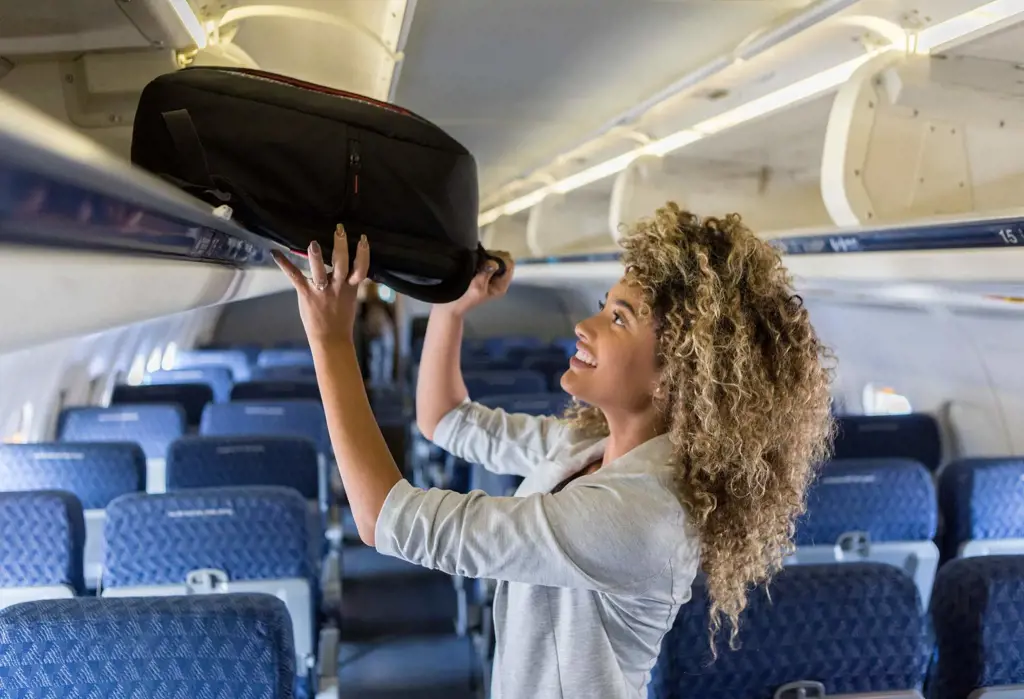
Baggage restrictions for international travel can vary depending on the airline, destination, and type of ticket you have. It is important to check with your airline before you travel to ensure you understand the specific restrictions that apply to your trip. However, there are some general guidelines that can help you understand the current baggage restrictions for international travel.
Weight restrictions:
Most airlines have weight restrictions for checked baggage and carry-on luggage. The weight limits can vary, but typically range from 20 to 50 pounds for checked bags and 15 to 25 pounds for carry-on bags. It is important to note that airlines may apply different weight restrictions depending on the class of service or destination.
Size restrictions:
In addition to weight restrictions, there are also size restrictions for both checked and carry-on baggage. The size limits can vary, but typically range from 62 to 80 linear inches (the sum of the width, height, and depth) for checked bags and 45 to 55 linear inches for carry-on bags. Some airlines may also have specific requirements for the dimensions of the bag, such as a maximum width or height.
Number of bags:
Most airlines have limits on the number of bags you can check and carry on. For checked bags, this could range from one to four bags, depending on the airline and ticket type. For carry-on bags, most airlines allow one bag plus a personal item, such as a purse or laptop bag. Again, it is important to check with your airline for the specific restrictions that apply to your trip.
Restricted items:
There are also restrictions on what you can bring with you in your baggage, both in checked and carry-on bags. This includes items such as liquids, gels, and aerosols, which must be in containers of 3.4 ounces or less and fit into a clear, quart-sized bag. Additionally, there are restrictions on firearms, sharp objects, and certain other items that are considered hazardous.
Excess baggage fees:
If your baggage exceeds the weight or size limits, you may be subject to excess baggage fees. These fees can vary depending on the airline and destination, but are generally charged per bag or per kilogram/ pound over the allowed limit. It is important to check with your airline for the specific fees that apply to your trip to avoid any surprises at the airport.
To summarize, the current baggage restrictions for international travel include weight and size limits for checked and carry-on bags, restrictions on certain items, limits on the number of bags you can bring, and potential excess baggage fees. It is important to check with your airline before you travel to understand the specific restrictions that apply to your trip. Failure to adhere to these restrictions could result in additional fees, delays, or even having to leave items behind.
Understanding Kansas' Travel Restrictions During the Quarantine Period
You may want to see also

Are there any specific rules or limitations for carry-on baggage on overseas flights?
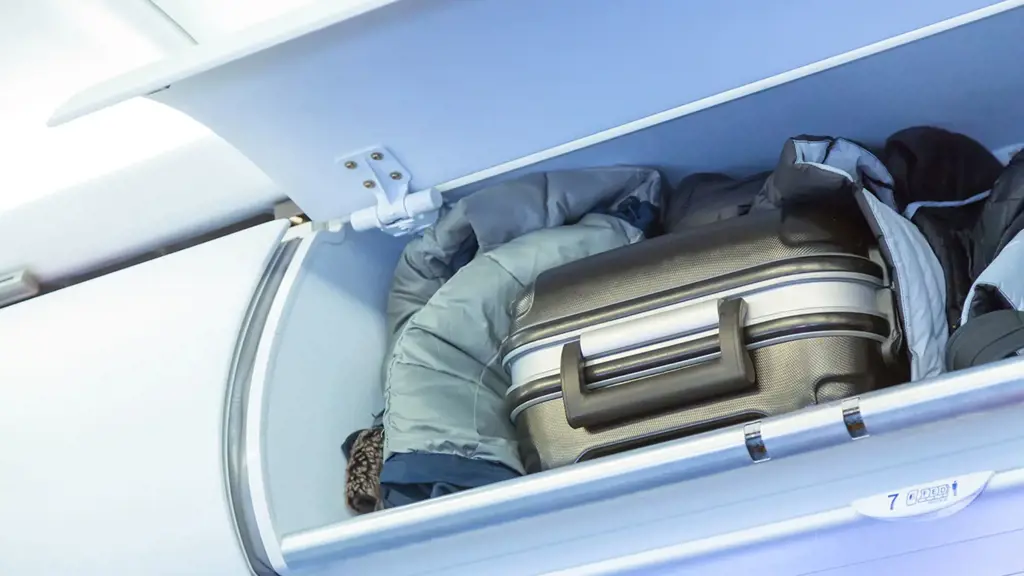
When traveling overseas, it is important to be aware of the rules and limitations for carry-on baggage. These regulations are in place to ensure the safety and comfort of all passengers on the flight. Here are some of the key rules and limitations to keep in mind:
- Size and weight restrictions: Most airlines have specific restrictions on the size and weight of carry-on baggage. The dimensions are typically given in terms of length, width, and height, with a maximum size allowed. The weight limit varies depending on the airline and class of travel. It is essential to check with your airline before traveling to ensure that your carry-on baggage meets the requirements.
- Liquid restrictions: The Transportation Security Administration (TSA) has strict regulations regarding the amount of liquids you can carry on a flight. Each passenger is allowed to bring a quart-sized bag of liquids, aerosols, gels, creams, and pastes in containers that are 3.4 ounces (100 milliliters) or less. All these containers must be placed in a clear, plastic, zip-top bag and presented separately for screening at the security checkpoint.
- Prohibited items: There are certain items that are not allowed in carry-on baggage. These include sharp objects like knives, scissors, and nail clippers with blades longer than four inches. Additionally, firearms, explosives, and flammable materials are strictly prohibited. It is important to familiarize yourself with the list of prohibited items to avoid any issues at the security checkpoint.
- Additional restrictions for specific countries: Some countries have additional rules and limitations for carry-on baggage. For example, in certain countries, laptops and other electronic devices must be removed from their cases and screened separately. It is advisable to research the specific regulations of the country you are traveling to and comply with them accordingly.
- Limited space: The overhead compartments in the cabin have limited space, especially on international flights with a higher number of passengers. It is important to pack efficiently and avoid bringing excessive carry-on baggage to ensure that there is enough space for everyone.
To ensure a smooth and hassle-free journey, it is recommended to pack your carry-on baggage carefully and follow all the rules and limitations set by the airlines and airport authorities. Failure to comply with the regulations may result in delays at the security checkpoint or even denial of boarding. By being aware of these rules and limitations, you can ensure a stress-free travel experience.
The Impact of Extended Travel Restrictions on Global Tourism and Economies
You may want to see also

Are there any restrictions on the weight or dimensions of checked baggage when traveling abroad?
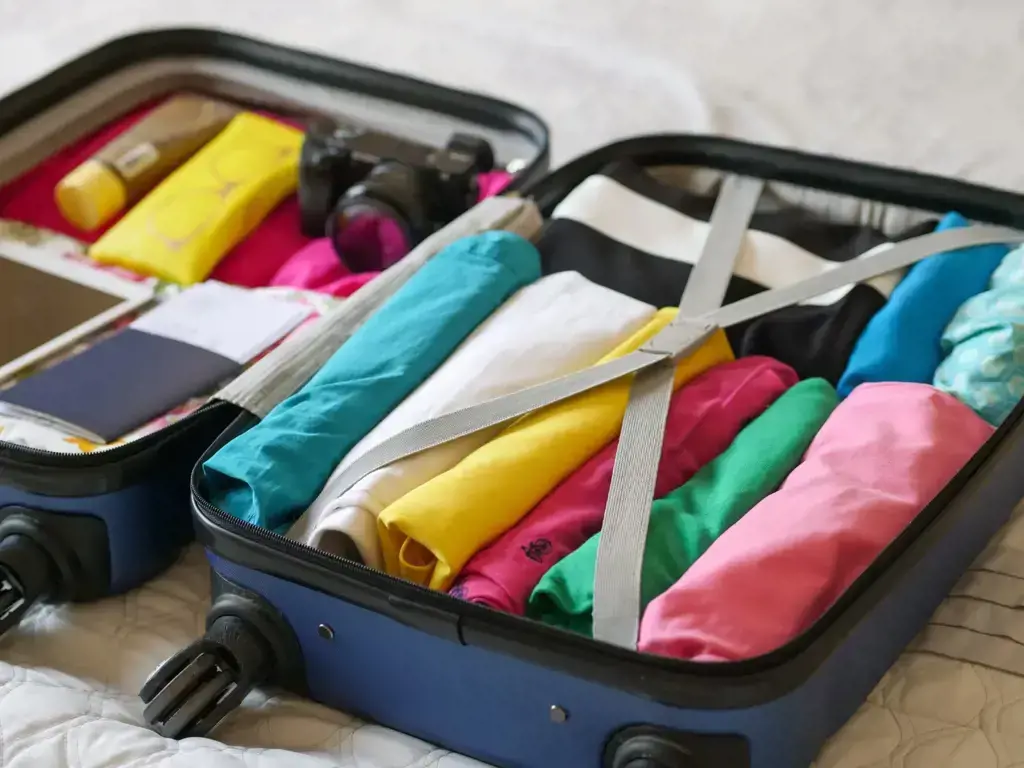
When traveling abroad, there are often restrictions on the weight and dimensions of checked baggage. These restrictions are in place to ensure the safety and efficiency of the airline industry. In this article, we will explore some common restrictions and guidelines for checked baggage when traveling abroad.
Weight Restrictions:
Most airlines have a weight limit for checked baggage, typically between 50 and 70 pounds (23 to 32 kilograms) depending on the airline and the class of travel. It is important to note that exceeding the weight limit may result in additional fees or the requirement to repack your luggage. To avoid any issues, it is recommended to weigh your luggage before heading to the airport.
Dimension Restrictions:
In addition to weight, airlines also have restrictions on the dimensions of checked baggage. This includes the length, width, and height of the bag. These dimensions are usually measured by adding up the three sides of the baggage. Typically, the maximum dimensions allowed are around 62 linear inches (158 centimeters) for most airlines. If your bag exceeds these dimensions, it may not be accepted as checked baggage and you may have to make alternative arrangements.
Oversized or Overweight Baggage:
If your baggage exceeds the weight or size limit set by the airline, it is considered oversized or overweight baggage. In such cases, additional fees will apply, and you may need to make special arrangements with the airline. Some airlines may allow you to transport oversized or overweight baggage for an additional fee, while others may require you to ship it separately as cargo. It is essential to check with your specific airline for their policies regarding oversized and overweight baggage.
Special Items:
Certain items, such as musical instruments, sports equipment, and fragile items, may require special handling or incur additional fees. Some airlines have specific policies and procedures for transporting these items, so it is important to contact the airline in advance to understand their requirements. For example, some instruments may need to be transported in a specific case, and sports equipment may need to be packed in a particular manner.
Packing Tips:
To ensure compliance with weight and dimension restrictions, here are some tips for packing your checked baggage:
- Use a lightweight suitcase or bag to minimize the overall weight of your luggage.
- Distribute the weight evenly across your bags to prevent overloading one suitcase.
- Utilize packing cubes or compression bags to maximize space and reduce bulk.
- Remove unnecessary items from your luggage to minimize weight.
- Consider shipping bulky or heavy items separately to avoid exceeding weight limits.
In conclusion, when traveling abroad, it is important to be aware of the restrictions on weight and dimensions for checked baggage. By knowing the rules in advance, you can avoid additional fees and potential inconveniences. Always check with your specific airline for their policies and guidelines, as they may have specific requirements for oversized or special items. With proper planning and packing techniques, you can ensure a smooth and hassle-free travel experience.
Navigating Current New Mexico Travel Restrictions: What You Need to Know
You may want to see also

Are there any restrictions on bringing specific items or substances in my luggage when traveling overseas?
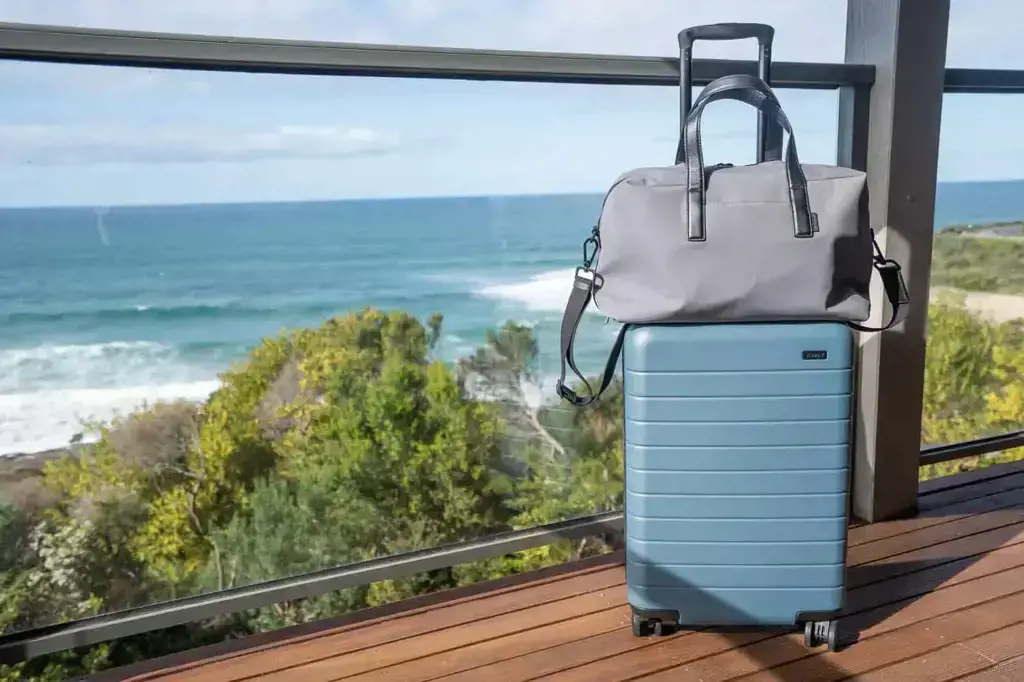
When traveling overseas, it is important to be aware of the restrictions on bringing specific items or substances in your luggage. These restrictions are in place to ensure the safety and security of both travelers and the countries they are visiting. Violating these restrictions can result in fines, confiscation of items, or even legal consequences. It is essential to familiarize yourself with the rules and regulations of the specific country you are visiting before you pack your bags.
One common restriction is on bringing certain medications or substances. Different countries have different regulations on what medications can be brought in, and some medications may require a prescription or a doctor's note to be presented at customs. It is important to check the specific regulations of the country you are visiting as some medications that are legal in your home country may be illegal in other parts of the world.
Another restriction is on bringing certain foods or agricultural products. Many countries have strict rules on bringing in fruits, vegetables, meat, dairy products, and other food items. This is to prevent the introduction of pests, diseases, or invasive species that could harm local environments and industries. It is important to check the agricultural restrictions of the country you are visiting and avoid packing any prohibited items.
Travelers should also be aware of restrictions on bringing weapons or dangerous items in their luggage. These items can include firearms, explosives, knives, and other potentially harmful objects. Most countries have strict regulations on the importation of weapons and dangerous items, and violations of these regulations can lead to serious penalties. It is crucial to research and follow the regulations of the country you are visiting to avoid any legal issues.
In addition to these specific items, there may be restrictions on bringing certain types of technology or electronic devices. For example, some countries have regulations on drones or other unmanned aircraft systems. It is important to check the regulations regarding these devices before bringing them with you on your trip.
When traveling with liquids, gels, or aerosols, it is essential to follow the restrictions set by the Transportation Security Administration (TSA) and other relevant authorities. These restrictions usually limit the size of containers and require them to be placed in a clear, resealable plastic bag. Be sure to familiarize yourself with the specific restrictions and follow them to ensure a smooth security screening process.
To avoid any issues with restricted items in your luggage, it is advisable to pack your bags carefully and thoroughly check the regulations of the country you are visiting. Some countries have a dedicated customs website that provides detailed information about what can and cannot be brought into the country. Additionally, contacting the embassy or consulate of the country you are visiting can also provide you with accurate and up-to-date information.
In conclusion, when traveling overseas, it is important to be aware of the restrictions on bringing specific items or substances in your luggage. This includes medications, foods, weapons, technology, and liquids. Violating these restrictions can have serious consequences, so it is essential to familiarize yourself with the regulations of the country you are visiting. By doing so, you can ensure a smooth and hassle-free travel experience while respecting the laws and regulations of the country you are visiting.
Exploring the US Virgin Islands: An Update on Travel Restrictions and Guidelines
You may want to see also

Are there any differences in baggage restrictions between different airlines or countries?

When it comes to traveling by air, one of the most important considerations is baggage restrictions. Different airlines and countries have their own rules and regulations regarding what you can bring on board and how much luggage you can check in. It is essential to be aware of these restrictions to avoid any inconvenience or extra charges.
The first difference you may encounter is between airlines. Each airline has its own set of rules when it comes to baggage restrictions. Some airlines may allow a certain weight limit for both checked and carry-on luggage, while others may have specific dimensions for the size of the bags. For example, a budget airline may have stricter rules compared to a full-service carrier. It is important to check the baggage policy of the airline you are flying with before packing your bags.
In addition to airline regulations, there may also be differences in baggage restrictions between countries. Some countries may have stricter security measures in place, which can affect what you can bring on board. For example, certain countries may have restrictions on the amount of liquids you can carry in your carry-on bag. These restrictions are in place to ensure the safety of all passengers and to comply with international security standards.
To avoid any issues, it is crucial to familiarize yourself with the baggage restrictions of the airline and the country you are traveling to. This can usually be done by visiting the airline's website or contacting their customer service. Pay attention to the weight and size limits for both carry-on and checked luggage, as exceeding these limits may result in additional charges or being asked to remove items from your bags. It is also important to know if there are any prohibited items that are not allowed on board, such as sharp objects or flammable materials.
To illustrate these differences in baggage restrictions, let's consider two examples. Say you are flying with Airline A, which allows a maximum weight of 23 kilograms for checked luggage and 7 kilograms for carry-on bags. However, you are traveling to Country X, which has stricter regulations and only allows a maximum weight of 20 kilograms for checked luggage and 5 kilograms for carry-on bags. In this case, you would need to adjust your packing accordingly to comply with the regulations of both the airline and the country.
Another example is when you are flying with Airline B, which allows a carry-on bag of up to 56 centimeters in length, 45 centimeters in width, and 25 centimeters in height. However, you are traveling to Country Y, which has a smaller size limit for carry-on bags, allowing only up to 55 centimeters in length, 40 centimeters in width, and 20 centimeters in height. In this situation, you would need to ensure that your carry-on bag meets the requirements of both the airline and the country.
In conclusion, there are indeed differences in baggage restrictions between different airlines and countries. It is essential to familiarize yourself with these restrictions to avoid any inconvenience or additional charges. Check the baggage policy of the airline you are flying with and the regulations of the country you are traveling to. Pay attention to weight limits, size limits, and any prohibited items. By being aware of the rules and regulations, you can ensure a smooth and hassle-free travel experience.
Exploring the Current Malaysia Travel Restrictions: What You Need to Know
You may want to see also
Frequently asked questions
The standard baggage restrictions for overseas travel vary depending on the airline and destination. However, most airlines allow passengers to bring one carry-on bag and one checked bag. The weight and size limits for these bags also vary but are usually around 50 pounds and 22x14x9 inches for a carry-on and 50-70 pounds and 62 linear inches for a checked bag.
Yes, there are certain restrictions on the type of items that can be packed in luggage for overseas travel. Generally, hazardous materials such as flammable liquids, explosives, and sharp objects are prohibited. Additionally, some countries have specific restrictions on certain items like food, plants, and animal products. It's always recommended to check with the airline and destination country's customs regulations before packing to ensure compliance.
Yes, you can bring electronic devices in your carry-on bag for overseas travel. This includes items such as laptops, tablets, smartphones, cameras, and portable chargers. However, it's important to note that these devices may need to be removed from your bag and scanned separately during the airport security screening process.
Yes, there is a limit on the amount of liquids you can bring in your carry-on bag for overseas travel. The standard rule is that liquids must be in containers that are 3.4 ounces (100 milliliters) or less, and all containers must fit into a single quart-sized transparent zip-top bag. Each passenger is limited to one quart-sized bag of liquids. Any liquids that exceed these limits must be placed in checked luggage.







